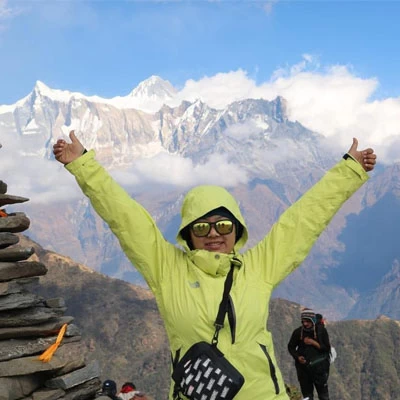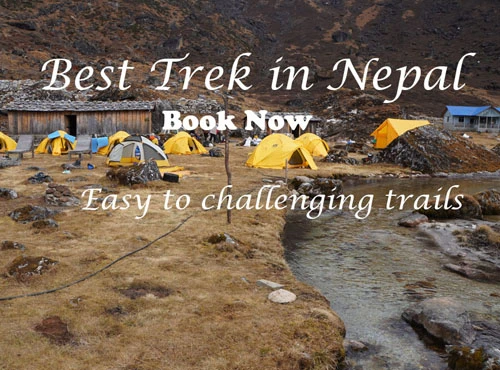Before arriving in Nepal
- Choose the trekking destination you wish to travel to in Nepal. Moon Himalaya Adventure has a variety of itineraries to offer. You can also customize your own preferred set of itineraries.
- Next, you can mail us at moonhimalayaadventure@gmail.com or fill out our inquiry form and send it to us. We will shortly get back to you after receiving your mail.
- Once you are with Moon Himalaya Adventure, you can free yourself from the burden of organizing a trek in Nepal, as we have experienced trip operators who will organize the trip for you to provide you with the best experience in the Himalayas.
Preparation on your side
Training for endurance and stamina
Overall, trekking in Nepal offers a thrilling and unforgettable experience for those who are willing to take on the challenge. However, it is important to properly prepare both physically and logistically by booking a reputable trekking agency, choosing the right route, and acquiring necessary permits and documents. Additionally, physical training for endurance and stamina is crucial for a successful trek. With the help of experienced guides and porters, trekkers can also immerse themselves in the rich cultural heritage of Nepal by visiting remote villages and interacting with the locals. No matter how much or how little experience you have with hiking, Nepal is a fantastic destination. Put on your hiking boots, grab your backpack, and get ready for the experience of a lifetime in the Himalayas.
Strengthening core muscles and legs
It is crucial for hiking in Nepal. Squats, lunges, and planks are great workouts to prepare your body for the trek. Increasing your endurance with activities that focus on your cardiovascular system, such as jogging, cycling, or swimming, can also be helpful. It is advisable to begin training at least three months before to the journey, progressively increasing both the intensity of the workouts and the duration of the workouts. Overtraining can cause injuries and setbacks, so it's crucial to pay attention to your body and not overdo it. In addition to having enough rest and sleep, proper diet and hydration are crucial for physical preparedness.
Being prepared for unexpected challenges and changes in weather conditions
The weather can be unpredictable and can change rapidly, so it is important to pack clothing and gear that can handle a range of temperatures and weather conditions. Also, it is important to be aware of the local culture and customs and to respect them while trekking. Keeping these things in mind can help assure a safe and successful hike in Nepal. While being prepared for unexpected weather and emergencies is important, it is still crucial to properly acclimatize to higher altitudes in order to prevent altitude sickness and have a safe trekking experience in Nepal.
Knowing altitude sickness and its prevention
It is another important aspect to consider when trekking in Nepal. Altitude sickness, also known as acute mountain sickness, can occur when traveling to high altitudes and can cause symptoms such as headaches, nausea, and dizziness. To prevent altitude sickness, it is recommended to gradually acclimatize to higher altitudes, stay hydrated, and avoid alcohol and smoking. In severe cases, descending to lower altitudes may be necessary. By being aware of altitude sickness and taking preventative measures, you can minimize the risk of experiencing this condition and enjoy your trekking adventure to the fullest. The itineraries by Moon Himalaya Adventure are prepared with an appropriate amount of time to acclimatize to the high altitude.
Packing essential gear and equipment
Some important items to consider include sturdy hiking boots, warm and waterproof clothing, a first aid kit, sleeping bags, trekking poles, and other personal gear.
During the Trek
Following environmental guidelines and practicing responsible tourism
This includes avoiding littering, respecting local customs and traditions, and minimizing the impact on the natural environment.
Staying hydrated and well-nourished
The high altitude and physical exertion can quickly dehydrate the body and drain energy levels. It is recommended to drink at least 3-4 liters of water per day and to eat a balanced diet that includes carbohydrates, protein, and healthy fats. Snacks such as nuts, energy bars, and dried fruit can provide a quick boost of energy on the trail. Taking breaks and resting when needed can also help prevent exhaustion and altitude sickness. By taking care of your body, you can fully enjoy the stunning scenery and unique cultural experiences that Nepal
Keeping safe
Make sure to follow safety guidelines and stick to established trails. It is also recommended to have a first aid kit and emergency supplies on hand. In addition, respecting the local culture and customs is essential. Be mindful of your behavior and interactions with locals.
Learning the local language and customs
While English is widely spoken in tourist areas, it is always appreciated when visitors make an effort to communicate in the local language. This can help to break down cultural barriers and foster a deeper understanding of the local culture. Additionally, interacting with locals can provide valuable insights into the history, traditions, and way of life in Nepal. Whether it's through a homestay, a local guide, or simply striking up a conversation with a shopkeeper, taking the time to connect with Nepali people can be a rewarding part of your trekking experience.
Acclimatization to high altitudes
As you climb higher, the air becomes thinner and the oxygen levels decrease, which can cause altitude sickness. It is recommended to acclimatize by gradually ascending to higher altitudes and spending a few days there to allow your body to adjust. Drinking plenty of water, avoiding alcohol and smoking, and taking medication, if necessary, can also help prevent altitude sickness. It is important to pay attention to your body and seek medical attention if you experience symptoms such as headache, nausea, or dizziness. Throughout the trek, it is recommended to stay in communication with your guide and to follow their advice for a safe and enjoyable experience. Proper acclimatization can make all the difference in having a safe and enjoyable trekking experience in Nepal.
In summary, trekking in Nepal offers a thrilling adventure filled with natural beauty and cultural experiences. It is recommended to properly prepare for the physical demands of the trek, including training, acclimatization, and packing appropriate gear. We encourage everyone to embark on a trekking adventure in Nepal and experience the beauty and culture that this country has to offer. With proper preparation and responsible tourism practices, you can help preserve these treasures for future generations while also creating unforgettable memories for yourself. So, pack your bags, lace up your hiking boots, and get ready for the adventure of a lifetime in Nepal!




